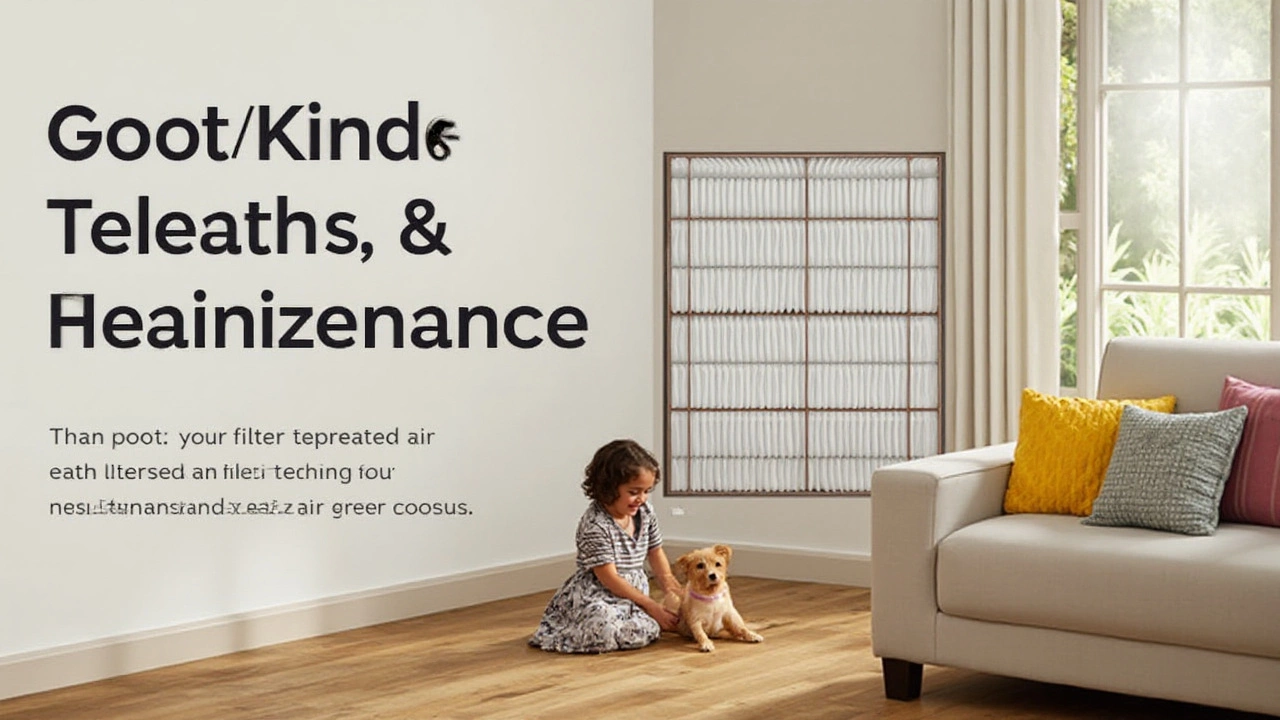Do Pleated Air Filters Hinder Airflow Efficiency?
 Jan, 27 2025
Jan, 27 2025
Pleated air filters are a common component in many heating and cooling systems, celebrated for their excellent capability to trap dust, allergens, and other particles. Yet, a lingering question remains among homeowners and HVAC enthusiasts alike: do these pleated designs restrict airflow, potentially hampering the performance of their systems?
To answer this, it's essential to understand not only how these filters work but also why they are favored in the first place. Pleated filters are made from a material folded into ridges, increasing the filter's surface area and boosting its efficiency in capturing airborne particles. However, the concern over reduced airflow might prompt you to think twice before upgrading from a basic flat filter to the more intricate pleated variety.
Delving into the relationship between airflow and HVAC performance, we uncover the potential trade-offs involved. While high-efficiency filters undoubtedly improve indoor air quality, they might also demand your climate control systems work harder to push air through the denser fabric. But fear not, as this doesn't spell doom for pleated filters. On the contrary, knowing how to balance air quality needs with system capacity can lead you to the perfect filter choice for your home.
- Understanding Pleated Air Filters
- Airflow and HVAC Performance
- Benefits of Pleated Filters
- Tips for Choosing the Right Filter
Understanding Pleated Air Filters
The world of air filters is vast and varied, populated with designs each claiming to be the best at keeping your home’s air clean and fresh. Among them, pleated air filters have garnered attention for their efficiency and effectiveness. These filters are constructed with sheets of filter media folded into a series of ridges, or ‘pleats’, increasing the surface area available to trap airborne particles. The concept is simple: the more surface area a filter has, the more contaminants it can capture. This fundamental design aspect is what makes pleated filters a favorite for homeowners interested in improving their indoor air quality without upgrading to more expensive systems.
Interestingly, the ridged texture of pleated filters not only enhances their ability to catch particles like dust and pollen but also improves their longevity. As these filters collect more debris across a larger area, they don’t get clogged as quickly as some non-pleated counterparts might. This attribute is instrumental in their rising popularity, especially in environments where high dust or pollen loads are a concern. However, some people worry about the airflow, or how the increased density might make it harder for air to move through. Yet, manufacturers often debunk these concerns by explaining how modern designs balance fiber density and surface area to maintain sufficient airflow.
In an interview with industry expert James Holden, he stated, "The advances in filter media technology have made it possible for pleated filters to provide high-efficiency filtration without significantly impacting airflow. The trick is in understanding the needs of your specific HVAC system and using a filter that complements it."
"The advent of pleated filters in residential settings has revolutionized how we think about air quality without sacrificing system performance," explains Dr. Leslie Carter, a prominent researcher in air filtration technology.With this insight, it becomes evident that pleated filters are a product of thoughtful engineering meant to strike the perfect balance between air cleaning capability and maintaining system efficiency. Choosing the right filter, however, comes down to understanding your existing HVAC system’s specifications and capabilities. Utilizing a filter that is too restrictive for your system's ability can lead to inefficiencies and increased energy bills, which underscores the importance of a considered choice.
Efficiency ratings, such as the Minimum Efficiency Reporting Value (MERV), help navigate these choices. Ratings for pleated filters typically range from 8 to 13 on the MERV scale, indicating their proficiency in capturing a wide range of particle sizes, from large dust specks to smaller unwanted particles like mold spores. Having this performance level can significantly improve the air quality of your living space, especially for households with allergies or those living in urban areas with higher pollution levels. It’s also useful to consider the environmental conditions present within your home when determining which filter to select. For instance, homes with pets might benefit from a higher rating due to the additional pet dander that circulates the air.

Airflow and HVAC Performance
When it comes to optimizing your home's environment, airflow and HVAC (Heating, Ventilation, and Air Conditioning) performance play critical roles. Adequate airflow ensures that air circulates freely through vents, distributing heat or cooling evenly. Any restriction in airflow can compromise this balance, leading to uneven room temperatures and overworked HVAC systems. Pleated air filters, with their dense fiber structure, have occasionally been accused of obstructing airflow. This misconception often arises from misunderstandings about how these filters interact with air systems.
The HVAC system's design is a key factor in understanding potential impacts. Ideally, these systems are built to accommodate resistance from filters. In most cases, using a pleated filter won't noticeably impact the system unless it's significantly clogged or not maintained. Modern HVAC units are typically robust enough to handle standard pleated filters, as they are engineered with certain airflow resistance in mind. Poor performance issues usually stem from clogged filters rather than their basic design. To ensure top performance, filters should be replaced every three months, or more frequently in households with pets or allergy sufferers.
When evaluating airflow and its effect on HVAC efficiency, one must consider the system's MERV (Minimum Efficiency Reporting Value) rating. The higher the MERV rating, the better the filter is at trapping particles but with increased potential for airflow restriction. While a higher MERV might suggest more blockages, it's crucial to remember that this is an intentional design choice to improve air quality. Many professionals suggest balancing air quality needs by selecting a filter with a MERV rating appropriate to your home and HVAC system's capacity. This balance is key to avoiding undue stress on the HVAC system while maintaining a clean, healthy environment.
"The right filter can enhance air quality without burdening the HVAC system, achieving that fine balance between efficient filtration and excellent system performance," HVAC expert John Green says.
| Filter Type | Resistance Level | Recommended MERV |
|---|---|---|
| Pleated | Medium | 7-13 |
| Fiberglass | Low | 1-4 |
| HEPA | High | 17-20 |
Given this information, it's clear that understanding your home's needs and the HVAC system specifications is essential for selecting the appropriate filter. A well-maintained HVAC system, equipped with the right filter, can not only enhance home comfort but also reduce the risk of costly repairs and increase the lifespan of the unit. So, when considering an air filter, do your research. Ensure it fits within the system's air resistance tolerance and promotes efficient performance. As with most home appliances, awareness and routine maintenance are critical to keeping things running smoothly and efficiently.

Benefits of Pleated Filters
Pleated air filters are not just a trendy choice for modern homes; they offer a range of tangible benefits that elevate them above their non-pleated counterparts. At the core of their design is the increased surface area. The pleats themselves, which resemble the gentle folds of an accordion, provide more extensive coverage, allowing the filter to capture a higher volume of dust and particles compared to flat filters. This means that more particles and allergens are taken out of circulation, leading to cleaner air that is crucial for those with respiratory issues or allergies. It's not uncommon for families to notice a marked difference in air quality and reduced respiratory irritation once they make the switch to pleated filters.
Let's delve into the mechanics that make these filters so effective. Each pleated air filter incorporates a dense web of fibers that trap particles. But while this aspect might seem like it could hinder airflow, manufacturers have continuously refined their designs to minimize any adverse effects. The idea is to strike a balance between air quality and system efficiency. As an added advantage, pleated filters often last longer before requiring replacement, meaning fewer trips to the store and less replacement frequency, bringing tangible cost savings over time. This improved durability stems from the filters' ability to hold more dirt without significant pressure drop, making your heating or cooling system run smoother for longer.
A study by the Environmental Protection Agency emphasized the importance of maintaining indoor air quality and how filters like pleated ones play a key role. According to their findings, better filtration not only improves air quality but can also enhance the overall energy efficiency of an HVAC system when correctly matched to the system's specifications. This is a crucial aspect to consider, especially in larger households where the system may be active most of the day. Moreover, improved air quality doesn't just benefit human health; your home appliances will likely last longer and perform better without the added burden of dust and debris clogging their components.
Besides these practical benefits, pleated filters also contribute environmentally by proving to be a better long-term investment. Think about the wastage that comes from frequently replacing flat filters – with pleated filters' longer lifespan, you're contributing less to landfill, thereby lowering your home's carbon footprint. This aligns with the growing trend toward more sustainable living practices. Many manufacturers are now designing pleated filters that can be recycled after their use, adding another layer of environmental friendliness to their appeal.
Investing in a pleated filter also opens doors to customizable filtration tailored to your specific needs. Some brands offer filters treated with specialized coatings to capture certain pollutants like mold spores or pet dander more effectively. As you navigate through the myriad of choices available, it's a good time to manually check filter specifications for compatibility and performance ratings that meet or exceed your expectations. Remember, the right pleated filter can be a game-changer for both home comfort and health.
Enhancing Value with Pleated Filters
The ability of pleated air filters to adapt and meet diverse needs makes them an invaluable asset in managing home air quality. As modern homes become increasingly aware of indoor pollutants and strive for energy-effective solutions, these filters have positioned themselves as a versatile option. Their affordability compared to high-tech air purifiers makes them an accessible first step toward better air without breaking the bank. Pleated filters empower homeowners to take control of their indoor environment, combining the benefits of improved air quality with the allure of cost savings and environmental stewardship. It's an investment that pays off in numerous ways, keeping you and your family breathing easy while reducing the strain on your airflow systems.

Tips for Choosing the Right Filter
When it comes to choosing the right air filter for your home, understanding the specific needs of your environment and your HVAC system is crucial. Before you make a decision, consider not only the air quality needs of your household but also how your HVAC system performs with different filters. Start by assessing the MERV (Minimum Efficiency Reporting Value) rating of pleated air filters. A higher MERV rating signifies a higher capability of the filter to trap particles, but it can also mean reduced airflow, making your system work harder. For most residential settings, a MERV rating between 8 and 13 offers a good balance between filtration efficiency and system ease.
It’s also important to think about the particular challenges your indoor space might face. If you’re living with furry friends, for instance, or someone with allergies, choosing a filter with a higher capacity to trap pet dander and tiny allergen particles can be beneficial. This doesn't just improve air quality but also promotes a healthier living environment. You might wonder, however, if it will cost you more energy. The U.S. Department of Energy reports that effective regular maintenance of air filters can significantly cut back on heating and cooling costs by up to 15%. This statistic emphasizes the importance of informed filter choices.
When purchasing filters, consider its frequency of replacement. The longevity of a filter impacts not only performance but also your budget in the long run. A higher-quality pleated air filter might initially cost more, but if you don't have to replace it as often, it could save you money over time. Keep a regular check on your filter condition, ideally every month, and replace it according to manufacturers' recommendations or when visibly dirty, which is typically every three months for most homes.
Additionally, compatibility with your existing HVAC system is vital. Not all filters fit universally, and some systems might be optimized for certain types of filters. Consult your HVAC manual or a professional if in doubt. An ill-fitting filter can lead to inefficiency or even damage. If you’re unsure about choosing the right pleated filter, it can also be helpful to seek expert advice.
"The best filter is one that not only cleans the air but also suits your system's capabilities," explains Dr. John Smith, a renowned HVAC specialist. "Balance efficiency with your system's airflow requirements for optimal results."Finally, consider the environmental impact of your filter choice. Many filters are becoming increasingly eco-friendly, with options for disposal and recycling after their lifespan. This not only helps the planet but also aligns with the sustainable values many are beginning to adopt.